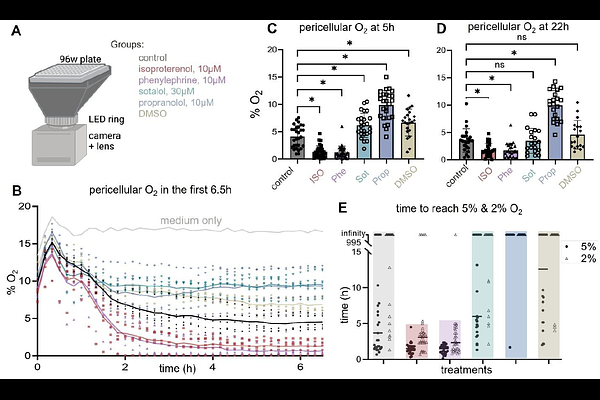Response of human iPSC-cardiomyocytes to adrenergic drugs assessed by high-throughput pericellular oxygen measurements

Response of human iPSC-cardiomyocytes to adrenergic drugs assessed by high-throughput pericellular oxygen measurements
Li, W.; McLeod, D.; Heinson, Y. W.; Kay, M. W.; Li, Z.; Entcheva, E.
AbstractRate-modulating drugs, such as adrenergic agonists and antagonists, are widely used in the treatment of cardiovascular conditions. Preclinical assessment of new rate and metabolism modulators can be augmented through the development of high-throughput (HT) methods that allow chronic measurements. Such approaches are best coupled with human induced pluripotent stem cell-derived cardiomyocytes (hiPSC-CMs) - a scalable experimental model of the human heart. Here, we evaluate the utility of long-term optical (label-free) measurements of pericellular oxygen in a HT format (96-well plates) for the assessment of the effectiveness of adrenergic drugs in hiPSC-CMs. Quantitative metrics were derived from these long-term measurements, e.g. steady-state pericellular oxygen and time to reach 5%, and we sought correlation to measurements performed in the same samples using all-optical electrophysiology. Adrenergic agonists significantly increased oxygen consumption rate, and this was best seen in the kinetics of initial depletion of pericellular oxygen, i.e. time to reach 5%. Adrenergic antagonists decreased oxygen consumption rate and their action was best quantified using steady-state values for pericellular oxygen after at least 5 hours. Drug type identification based on oxygen consumption rate correlated well with the acute measurements of spontaneous rate in the same samples. Furthermore, we showed that direct rate modulation with chronic optogenetic pacing detectably sped up the oxygen consumption rate and optogenetic transformation did not interfere with classification of adrenergic drugs. We conclude that HT label-free optical oxygen measurements may be a valuable approach for long-term non-invasive monitoring of the action of rate- and metabolism-modulating drugs in preclinical studies.